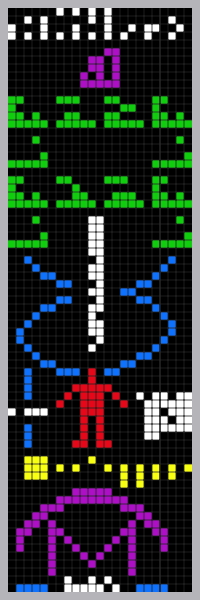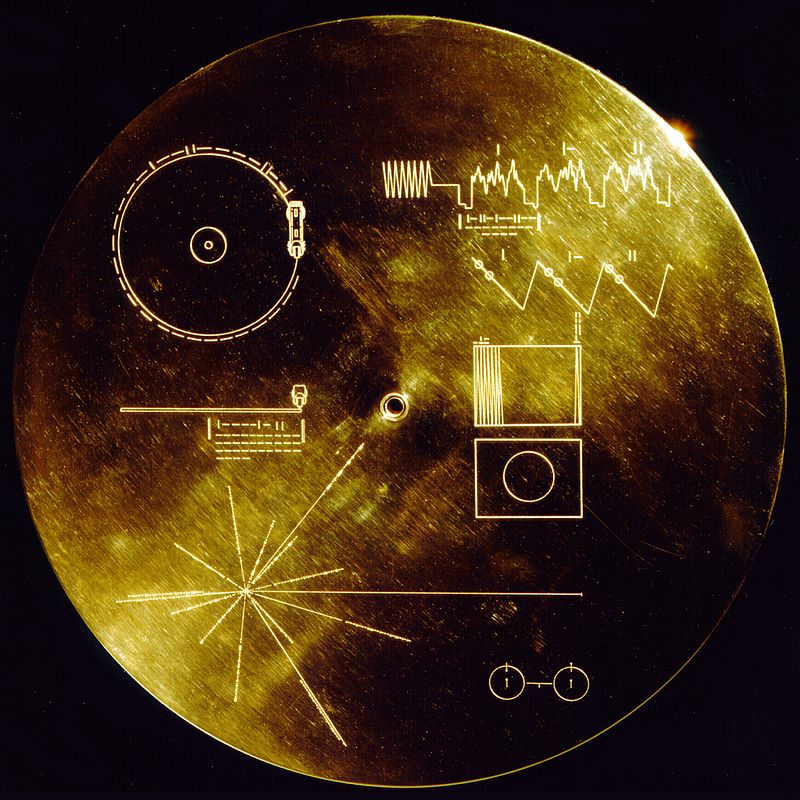Can you understand me? Video still via Thinking on YouTube.
This past weekend (May 26, 2018), an organization called Messaging Extraterrestrial Intelligence (METI) brought linguists and other researchers together in Los Angeles, California, to explore the question of whether and how we might communicate with an extraterrestrial civilization, if we should ever encounter one. The workshop – called Language in the Cosmos – was organized by METI as part of this year’s National Space Society International Space Development Conference (ISDC 2018).
In the past, messages targeting possible extraterrestrials – for example, the 1974 radio message beamed to space from Arecibo, or the Pioneer plaque, or Voyager Golden Record – have typically been encoded with principles of math and science, with the hope that they are universal subjects.
But this daylong workshop wasn’t about that form of communication. It was about language.
The Pioneer plaque, placed aboard the 1st 2 spacecraft ever to leave Earth for interstellar space, Pioneer 10 in 1972 and Pioneer 11 in 1973. SETI scientists have scoffed at using language to create interstellar messages, preferring instead to use images and the principles of math and science, but linguists think language might indeed be a possibility. Image via Wikimedia Commons. Click for an explanation of the Pioneer plaque.
For some decades, linguists have spoken of a universal grammar connecting the varied languages we find on Earth. The idea of a universal grammar is usually credited to Noam Chomsky, sometimes called the father of modern linguistics. Douglas Vakoch, president of METI, commented:
Chomsky has often said that if a Martian visited Earth, it would think we all speak dialects of the same language, because all terrestrial languages share a common underlying structure. But if aliens have language, would it be similar to ours? That’s the big question.
At METI’s workshop, two of the presentations – including a paper co-authored by Noam Chomsky – were optimistic that extraterrestrial languages might have a universal grammar with virtually the same architecture that we find on Earth. Vakoch said:
That’s a radical shift for SETI scientists, who have scoffed at the idea of creating interstellar messages inspired by natural languages.
Other papers from the workshop showed that even carefully built messages, such as the Voyager Golden Record, can easily be misinterpreted because the assumptions of humans and aliens might diverge wildly from one another.

The Arecibo radio message as sent 1974 from the Arecibo Observatory. It was the first intentional radio message beamed to space. Image via Wikimedia Commons. Click for an explanation of the 1974 message.
Prior to the workshop, Sheri Wells-Jensen, chair of the workshop and member of the Board of Directors of METI, wrote a very interesting series of blog posts at METI’s website on this subject. In the first post, she expressed the optimism of some linguists about using language to communicate with E.T.s:
Unless all the beings on [a distant] planet are linked into some kind of hive mind, their language situation could be very much like our own.
Why? She pointed out that:
There’s some evidence that the way our bodies are built (standing erect with two hands to manipulate objects and our particular standard set of sensing organs) has a lot to do with what kind of language we speak. If that’s true, we might be able to manage the language of aliens who are roughly humanoid, but the language spoken by sentient gas bags or intelligent snails would be forever beyond us.

The Voyagers’ Golden Record, launched from Earth in 1977. Image via Wikimedia Commons. Click for an explanation of the Golden Record message.
She also said that, after all:
Despite … arbitrary surface variation, human languages have an awful lot in common. Here’s a partial list. All languages have something like verbs and something like nouns (No, they don’t all have adjectives).
All languages have ways of talking about the past and about the future.
All languages have pronouns.
All languages have rules that we obey when making sentences.
The Parkes radio telescope in New South Wales, Australia, is one of the radio telescopes on Earth currently listening for radio signals from extraterrestrials. Image via CSIRO/Space.com.
As of this moment, we know of no inhabited exoplanets. Yet thousands of exoplanets are known now, in contrast to several decades ago, when the only planets we knew for certain existed were those in our own solar system. The TESS planet-hunter spacecraft – launched in April 2018 – will be scanning the nearest and brightest stars for signs of yet more exoplanets. What’s more, NASA has given a high priority to the search for habitable exoplanets, although, in NASA’s case, the word habitable most often refers to microbes.
Still, the idea of E.T.s is fascinating to all of us, and astronomers engaged in SETI (the Search for Extraterrestrial Intelligence) continue to be optimistic we might someday hear a radio signal from intelligent aliens. If so, linguists like those at METI are trying to lay some groundwork for bridging the language differences, assuming the E.T.s have a language.
In her blog posts, Wells-Jensen concluded:
So, the cumulative answer to the original question – would we be able to learn an alien language?’ — is ‘Probably not / maybe / I don’t even want to / I think so / who knows? / some of them, probably.’ And that’s about the best we can do for now.
Read Sheri Wells-Jensen’s 3 blog posts at METI:
Could we learn E.T.’s language – Part 1
Could we learn E.T.’s language – Part 2
Could we learn E.T.’s language – Part 3
Image via METI. Read METI’s mission statement.
Bottom line: Would there be commonalities between the language of extraterrestrials and our earthly languages? Could we eventually communicate? At a May 26, 2018, meeting of linguists and other experts in Los Angeles, some explained why they think it’s possible.
from EarthSky https://ift.tt/2sndwSn
Can you understand me? Video still via Thinking on YouTube.
This past weekend (May 26, 2018), an organization called Messaging Extraterrestrial Intelligence (METI) brought linguists and other researchers together in Los Angeles, California, to explore the question of whether and how we might communicate with an extraterrestrial civilization, if we should ever encounter one. The workshop – called Language in the Cosmos – was organized by METI as part of this year’s National Space Society International Space Development Conference (ISDC 2018).
In the past, messages targeting possible extraterrestrials – for example, the 1974 radio message beamed to space from Arecibo, or the Pioneer plaque, or Voyager Golden Record – have typically been encoded with principles of math and science, with the hope that they are universal subjects.
But this daylong workshop wasn’t about that form of communication. It was about language.
The Pioneer plaque, placed aboard the 1st 2 spacecraft ever to leave Earth for interstellar space, Pioneer 10 in 1972 and Pioneer 11 in 1973. SETI scientists have scoffed at using language to create interstellar messages, preferring instead to use images and the principles of math and science, but linguists think language might indeed be a possibility. Image via Wikimedia Commons. Click for an explanation of the Pioneer plaque.
For some decades, linguists have spoken of a universal grammar connecting the varied languages we find on Earth. The idea of a universal grammar is usually credited to Noam Chomsky, sometimes called the father of modern linguistics. Douglas Vakoch, president of METI, commented:
Chomsky has often said that if a Martian visited Earth, it would think we all speak dialects of the same language, because all terrestrial languages share a common underlying structure. But if aliens have language, would it be similar to ours? That’s the big question.
At METI’s workshop, two of the presentations – including a paper co-authored by Noam Chomsky – were optimistic that extraterrestrial languages might have a universal grammar with virtually the same architecture that we find on Earth. Vakoch said:
That’s a radical shift for SETI scientists, who have scoffed at the idea of creating interstellar messages inspired by natural languages.
Other papers from the workshop showed that even carefully built messages, such as the Voyager Golden Record, can easily be misinterpreted because the assumptions of humans and aliens might diverge wildly from one another.

The Arecibo radio message as sent 1974 from the Arecibo Observatory. It was the first intentional radio message beamed to space. Image via Wikimedia Commons. Click for an explanation of the 1974 message.
Prior to the workshop, Sheri Wells-Jensen, chair of the workshop and member of the Board of Directors of METI, wrote a very interesting series of blog posts at METI’s website on this subject. In the first post, she expressed the optimism of some linguists about using language to communicate with E.T.s:
Unless all the beings on [a distant] planet are linked into some kind of hive mind, their language situation could be very much like our own.
Why? She pointed out that:
There’s some evidence that the way our bodies are built (standing erect with two hands to manipulate objects and our particular standard set of sensing organs) has a lot to do with what kind of language we speak. If that’s true, we might be able to manage the language of aliens who are roughly humanoid, but the language spoken by sentient gas bags or intelligent snails would be forever beyond us.

The Voyagers’ Golden Record, launched from Earth in 1977. Image via Wikimedia Commons. Click for an explanation of the Golden Record message.
She also said that, after all:
Despite … arbitrary surface variation, human languages have an awful lot in common. Here’s a partial list. All languages have something like verbs and something like nouns (No, they don’t all have adjectives).
All languages have ways of talking about the past and about the future.
All languages have pronouns.
All languages have rules that we obey when making sentences.
The Parkes radio telescope in New South Wales, Australia, is one of the radio telescopes on Earth currently listening for radio signals from extraterrestrials. Image via CSIRO/Space.com.
As of this moment, we know of no inhabited exoplanets. Yet thousands of exoplanets are known now, in contrast to several decades ago, when the only planets we knew for certain existed were those in our own solar system. The TESS planet-hunter spacecraft – launched in April 2018 – will be scanning the nearest and brightest stars for signs of yet more exoplanets. What’s more, NASA has given a high priority to the search for habitable exoplanets, although, in NASA’s case, the word habitable most often refers to microbes.
Still, the idea of E.T.s is fascinating to all of us, and astronomers engaged in SETI (the Search for Extraterrestrial Intelligence) continue to be optimistic we might someday hear a radio signal from intelligent aliens. If so, linguists like those at METI are trying to lay some groundwork for bridging the language differences, assuming the E.T.s have a language.
In her blog posts, Wells-Jensen concluded:
So, the cumulative answer to the original question – would we be able to learn an alien language?’ — is ‘Probably not / maybe / I don’t even want to / I think so / who knows? / some of them, probably.’ And that’s about the best we can do for now.
Read Sheri Wells-Jensen’s 3 blog posts at METI:
Could we learn E.T.’s language – Part 1
Could we learn E.T.’s language – Part 2
Could we learn E.T.’s language – Part 3
Image via METI. Read METI’s mission statement.
Bottom line: Would there be commonalities between the language of extraterrestrials and our earthly languages? Could we eventually communicate? At a May 26, 2018, meeting of linguists and other experts in Los Angeles, some explained why they think it’s possible.
from EarthSky https://ift.tt/2sndwSn

Aucun commentaire:
Enregistrer un commentaire